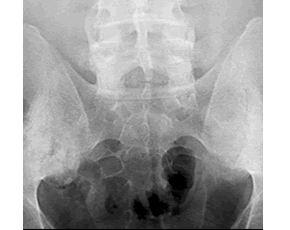 The spondyloarthropathies (SpA) are a group of related conditions that include ankylosing spondylitis (AS), reactive arthritis, psoriatic arthritis, the arthritis associated with inflammatory bowel disease, and undifferentiated spondyloarthropathy. Axial involvement (i.e. axial SpA) in these disorders tends to be slowly progressive, requiring in many cases years to decades of clinical symptoms to develop radiographic manifestations. This lag in objective radiographic findings, combined with a lack of other reliable diagnostic biomarkers for axial SpA, can hamper appropriate early diagnosis and treatment in many patients. Here, Rudwaleit et al (Arthritis Rheum 2009; 60(3): 717) explore clinical and radiographic outcomes in a prospective cohort comprised of patients with early radiographic and non-radiographic SpA.
The spondyloarthropathies (SpA) are a group of related conditions that include ankylosing spondylitis (AS), reactive arthritis, psoriatic arthritis, the arthritis associated with inflammatory bowel disease, and undifferentiated spondyloarthropathy. Axial involvement (i.e. axial SpA) in these disorders tends to be slowly progressive, requiring in many cases years to decades of clinical symptoms to develop radiographic manifestations. This lag in objective radiographic findings, combined with a lack of other reliable diagnostic biomarkers for axial SpA, can hamper appropriate early diagnosis and treatment in many patients. Here, Rudwaleit et al (Arthritis Rheum 2009; 60(3): 717) explore clinical and radiographic outcomes in a prospective cohort comprised of patients with early radiographic and non-radiographic SpA.
Methods
Participants enrolled in the German Spondyloarthritis Inception Cohort (GESPIC) were studied. To be included, patients had to have inflammatory back pain of less than 10 years duration with radiographic sacroiliac involvement (designated as AS) or without radiographic changes (designated as non-radiographic SpA). Those with non-radiographic SpA were required to fulfill additional diagnostic criteria, based on a modification of the European Spondyloarthropathy Study Group Criteria. Participants, enrolled from 13 centers in Germany, were evaluated every 6 months for the first 2 years, and annually thereafter, with clinical, laboratory, and radiographic parameters collected at baseline and longitudinally.
Results
Among the 462 patients were included, 236 were diagnosed with AS at enrollment (51%), of which half had symptoms for less than 5 years. Patients with non-radiographic SpA (n=226) had symptoms for a mean of 2.6 years. The proportion of patients receiving therapy with NSAIDs, DMARDs, and TNF inhibitors was similar between the groups.
Comparing AS patients with symptoms less than 5 years to non-radiographic SpA patients, AS patients were more likely to be male (66% vs. 43%; p<0.001); however, there was no difference in age, age at disease onset, HLA-B27 positivity, family history of SpA, proportion with inflammatory back pain, peripheral arthritis, enthesitis, uveitis, dactylitis, psoriasis, or inflammatory bowel disease (currently or reported history). Among clinical measures, there was no difference in disease activity (measured by the Bath Ankylosing Spondylitis Disease Activity Index (BASDAI)), overall pain, fatigue, or morning stiffness.
Functional and radiographic measures differed between the groups. The mean Bath Ankylosing Spondylitis Functional Index (BASFI) was significantly better in non-radiographic SpA patients compared to those with AS (2.5 vs. 3.1, respectively; p<0.001) reflecting overall better spinal mobility and lateral spinal flexion in the non-radiographic SpA group. Both mean CRP and ESR were significantly higher in AS patients compared to non-radiographic SpA patients (14.4 mg/L vs. 10.9 mg/l, respectively; p<0.001 for CRP and 21 vs 14 mm/hr, respectively; p=0.002 for ESR). As expected, radiographic sacroiliitis was lower in the non-radiographic SpA groups, but also the occurrence of bridging and non-bridging syndesmophytes. Male gender and CRP level, but not presence of HLA-B27, were the biggest predictors of radiographic findings, while HLA-B27 was associated with earlier age at onset. The association of HLA-B27 with age of onset did not differ according to whether the patient has AS or non-radiographic SpA.
Conclusions
Compared to those with AS of comparable disease duration, those with non-radiographic SpA, on average, demonstrated lower levels of systemic inflammation and better function. Other clinical parameters, such as symptoms, disease features, and the presence of HLA-B27, were not different.
Editorial Comment
This is the largest study, to date, comparing disease features in the early spondyloarthropathies. One of the most interesting findings revealed by the study is a lack of a difference in clinical symptoms, despite differences in observable damage. This could suggest that the processes responsible for damage (at least early damage) may be different from those causing symptoms. This highlights the difficulty that can be encountered in establishing early diagnoses in these patients, who may lack HLA-B27, elevated inflammatory markers, or radiographic evidence of disease, but still may have the same intensity of symptoms as a patient who has these markers. Longitudinal follow-up on these patients will be key to understanding what early features are associated with development of radiographic damage in the patients without radiographic findings at baseline.

